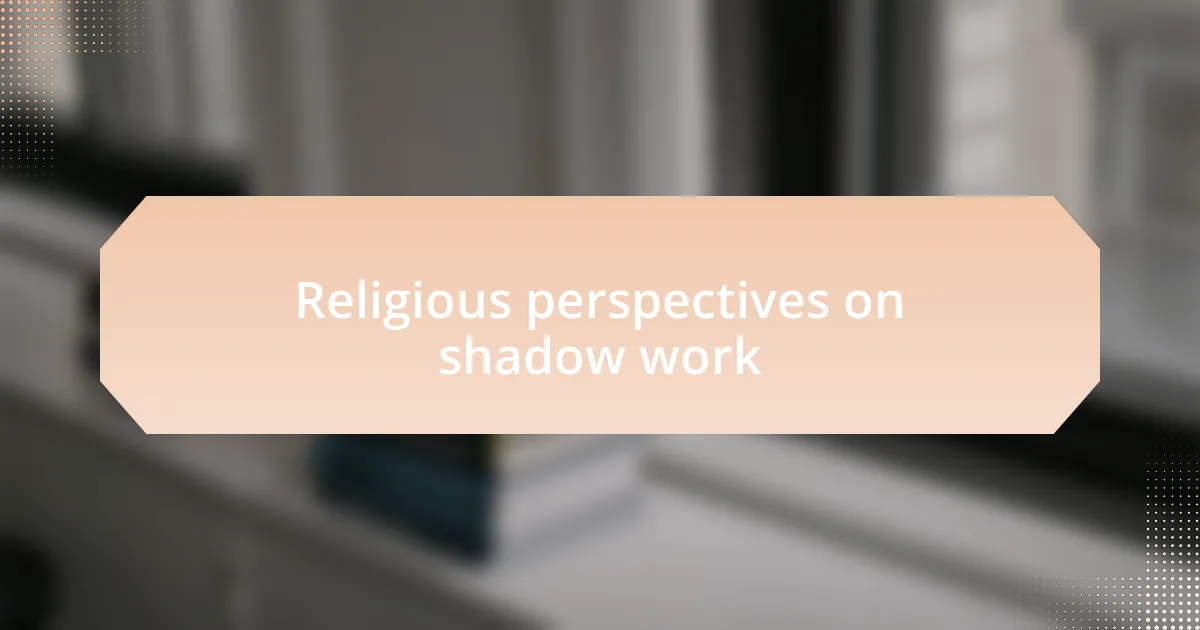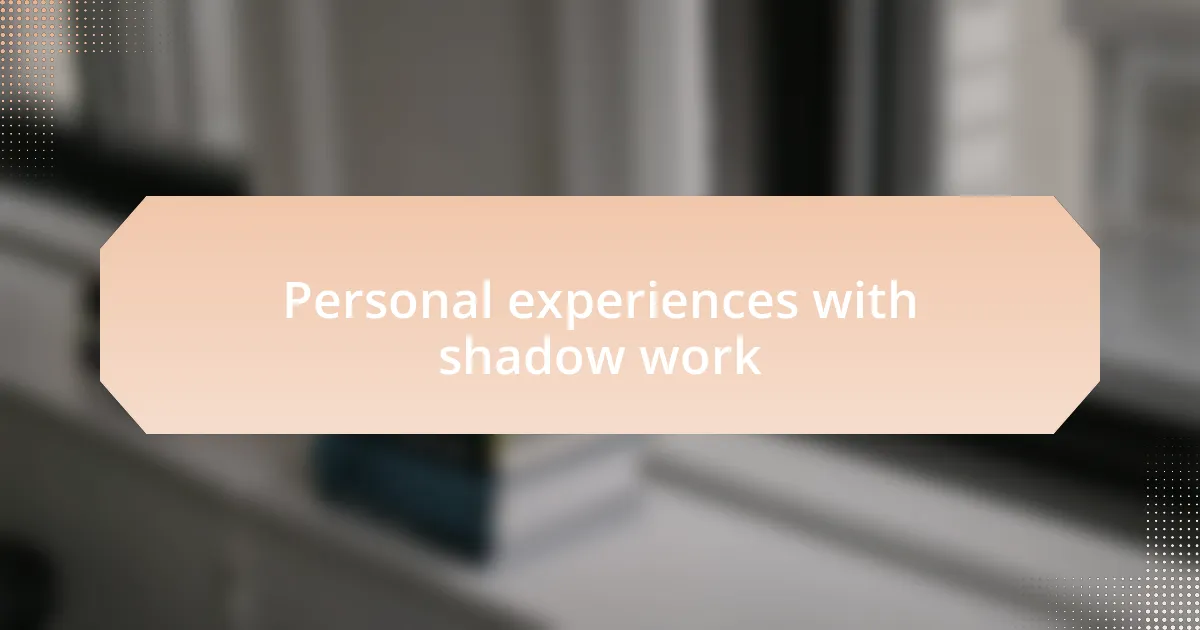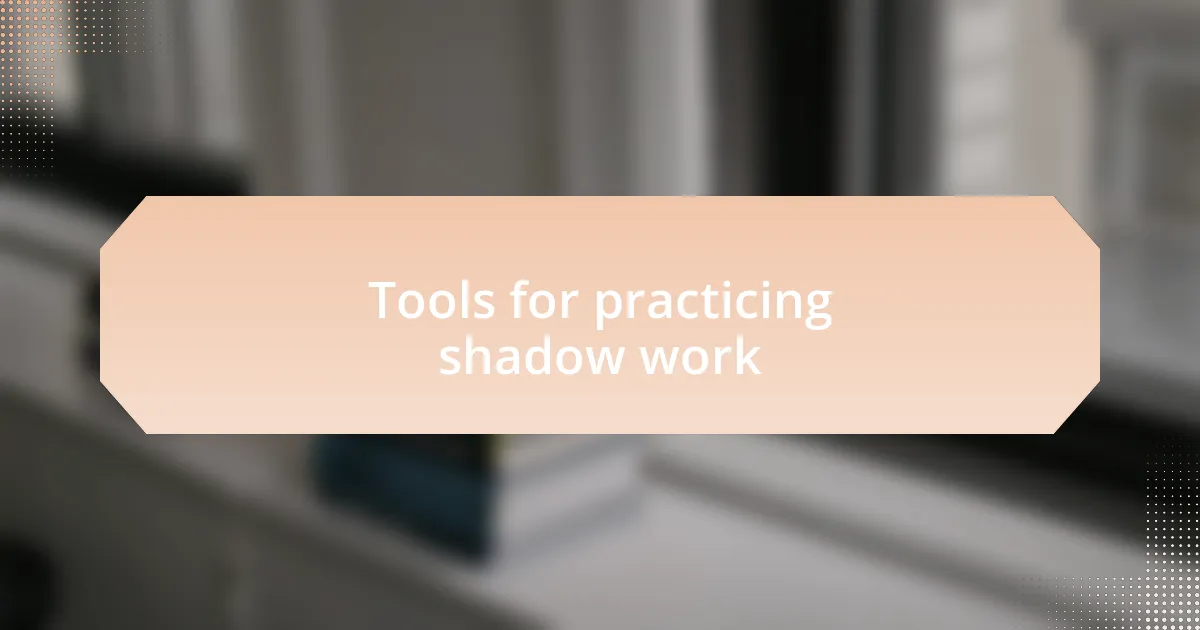Key takeaways:
- Shadow work involves confronting hidden emotions and experiences to foster personal growth and self-awareness.
- It enhances relationships by enabling open communication and reducing projection of insecurities onto others.
- Practices like journaling and meditation are effective tools for exploring and understanding one’s inner turmoil.
- Insights gained from shadow work, such as self-compassion and enhanced creativity, lead to a more authentic and fulfilling life.

Understanding shadow work
Shadow work is the process of exploring the parts of ourselves that we often keep hidden—the emotions, thoughts, and memories that can shape our behavior and beliefs. I remember my first encounter with shadow work; it felt daunting as I faced aspects of myself that I had long avoided. Have you ever stumbled across feelings that seemed buried deep? It’s in those moments of confrontation that transformation begins.
Diving into shadow work can feel like peeling back layers of an onion, revealing vulnerabilities and fears. I distinctly recall a moment when I unearthed a fear of rejection that influenced many of my relationships. As unsettling as it was to confront that truth, it was also liberating; acknowledging my shadow allowed me to better understand my reactions and patterns.
What often surprises people about shadow work is its emotional intensity. When I embarked on this journey, I encountered both sadness and relief. It’s essential to remember that grappling with these feelings is a sign of growth. Have you ever felt like you were holding onto a heavy burden? Letting it go, even momentarily, can open doors to a lighter, more authentic self.

Importance of shadow work
Shadow work is crucial for personal development, as it enables us to recognize and integrate parts of ourselves that we tend to ignore. I recall a particularly eye-opening session where I confronted my fear of failure. It struck me how much this unacknowledged fear had held me back from taking risks and seizing opportunities. Have you ever considered how much your hidden fears might be influencing your choices?
In pursuing shadow work, I discovered an unexpected sense of empowerment. By delving into my suppressed emotions, I began to dismantle the barriers I had built around my heart. This process allowed me to cultivate compassion for myself, a realization I hadn’t previously explored. What if embracing our vulnerabilities could lead to a deeper connection with ourselves and others?
Another significant aspect of shadow work lies in the healing power it provides through self-awareness. I often reflect on how understanding my triggers transformed my relationships with family and friends. Instead of projecting my insecurities onto others, I learned to communicate my feelings openly. Isn’t it fascinating how confronting our shadows can lead to more authentic connections with those we care about?

Religious perspectives on shadow work
Shadow work can be viewed through various religious lenses, each offering unique insights into personal healing. For instance, in Christianity, confronting one’s sins and flaws is akin to shadow work. I’ve often found solace in the idea of confession, where revealing hidden aspects of ourselves not only fosters forgiveness but also paves the way for spiritual renewal. How many of us can relate to the weight that lifted after acknowledging our failures?
In Buddhism, shadow work aligns with the concept of recognizing suffering and ignorance as essential steps toward enlightenment. When I practiced mindfulness, I realized that acknowledging my darker thoughts was not a sign of weakness, but rather a path to deeper understanding. Have you ever sat in quiet contemplation, only to unearth uncomfortable truths about your mindset? It’s a powerful realization that such awareness is vital for liberation.
When examining shadow work from a Hindu perspective, the practice of self-inquiry echoes the process of sifting through the layers of the self. I’ve explored how my attachments, often hidden, create cycles of suffering. Could it be that by facing these attachments, we can achieve a greater sense of peace? The journey through shadow work, with religious frameworks, enriches our understanding of the self, transforming turmoil into tranquility.

Personal experiences with shadow work
Diving into shadow work has been a profoundly personal experience for me. I remember one particular night, sitting on the floor with old journals scattered around me, feeling a mix of anxiety and curiosity. As I read through my own words, I confronted feelings of shame that I had buried for years. It was unsettling but ultimately liberating—have you ever unearthed something about yourself that surprised you?
The emotional weight of shadow work can be overwhelming. When I started to face my fears of inadequacy, I often felt a surge of doubt trying to pull me back into my comfort zone. Yet, each time I embraced those feelings instead of avoiding them, I noticed that they slowly transformed into sources of strength. Isn’t it remarkable how acknowledging what we fear can shift our perception entirely?
I often find myself reflecting on how shadow work has reshaped my relationships. By confronting my tendencies toward criticism and judgment, I’ve learned to communicate more openly. It’s fascinating—have you ever noticed how your inner world mirrors your interactions with others? For me, this realization was a turning point; it opened the door to deeper connections built on understanding rather than avoidance.

Tools for practicing shadow work
One of the most effective tools I discovered while practicing shadow work is journaling. I’ve found that writing down my thoughts—not just the pleasant ones, but the difficult emotions—helps me get clarity on my inner turmoil. Can you recall a moment when writing your feelings down helped you sort through confusion? For me, those pages turned into a mirror reflecting not just my struggles, but also my growth.
Meditation has also been a pivotal tool in my journey. It allows me to sit quietly with my thoughts, turning inward without distractions. During these moments, I’ve faced some of my deepest fears, the kind that often fled from my awareness. Have you ever noticed how stillness provides space for insights to emerge? Through regular practice, I’ve learned to observe my thoughts without judgment, which has been incredibly liberating.
Another essential tool is seeking guidance through books and resources on shadow work. I recall stumbling upon a particular guide that resonated deeply with me, offering fresh perspectives on my experiences. It was helpful to see my challenges mirrored in others’ stories, emphasizing that I’m not alone in this journey. Have you picked up a book that made you feel seen? These resources not only educate but also foster a sense of community, reminding us that exploring the shadows is a universal part of human experience.

Insights gained from shadow work
The insights I gained from shadow work have been transformative. One significant realization was that my fears often stemmed from past experiences, shaping my current reactions. Reflecting on an instance where I hesitated to trust someone, I recognized how childhood disappointments still influenced my adult relationships. Have you ever unearthed a hidden pattern in your life that can be traced back to your past?
Another profound insight was embracing the concept of self-compassion. I learned that it’s okay to have imperfections and that acknowledging them makes me human. I remember a time I berated myself for mistakes, only to discover that this harshness led to further shame. Instead, when I treated myself kindly, I opened the door for healing. Does it spark something in you to think about how you speak to yourself?
Lastly, I’ve found that integrating my shadow aspects has enhanced my creativity. As I explored those neglected parts of myself, I felt a surge of inspiration and authentic expression in my art. It was as though by accepting my wholeness, I unlocked a wellspring of creativity that had been bottled up. Have you noticed how connecting with your deeper selves can inspire new ideas and forms of expression?